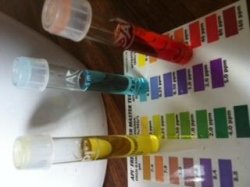lalo99 said:The bacteria do not consume NH4+ aka ammonium, the use NH3 ammonia. When in water ammonia/ammonium exist together. How much of each there is will depend on the pH and temperature of the water. The higher the pH, the more NH3 there will be, which is why the advice is to cycle at about 8.3 pH. The same is true for temp, but to a much lesser extent.
Once you get below 6.5 pH there is almost no NH3, it is all NH4+. This is why the cycle seems to stop at that level. he bacteria are ultimately able to adapt and thrive at lower levels but that is another story.
While it is correct to say that NH3 is the more toxic form of ammonia, it is incorrect to say NH4+ is completely non-toxic. NH3 at levels of about .05 ppm is harmful to fish and much higher can become fatal fairly fast. And exposure times need not be long. NH4+ when it is present for extended periods or at higher levels can cause burns but this is nowhere near as damaging as the NH3. This can enter the fish's system through the gills whereas the NH4+ is a larger and can not. So it does it greatest harm externally.
The good news is that at your pH and Temperature there is almost no NH3 present. Until your test kit reads over 2 ppm your fish are not in any short term danger from NH3 levels. However, it is also important to realize the the toxicity of nitrite increase as the pH drops.
Ammonia detoxifiers can screw heck out of ammonia test kit results. So at this time we need to look elsewhere for the answers. Nitrite readings can be an excellent place to start. If you have ammonia oxidizing bacteria working in a tank, then we know that should make nitrites. If nitrite readings are rising it means more nitrite than nitrite oxidizers can handle. Once nitrite falls it means the nitrite eaters are catching up and when nitrite is 0 it means there are the right number of nitrite oxidizers to handle all the nitrite the ammonia eaters are producing. But due to the nature of the nitrite vs the ammonia oxidizers, ammonia always drops to before nitrites do. Also, if the is more ammonia than your ammonia eaters can handle, there nitrate they produce should be more than the nitrite eaters cans handle, and that means you get a nitrite reading until they catch up. So, if one is constantly getting ammonia reading but nitrites are staying at 0 one of two things is reasonable to assume.
One- the ammonia kit is giving false readings because the nitrite kit shows this with its 0 readings. Two- you have ammonia and the nitrite kit is bad. Given that certain dechlorinators and most ammonia detoxifyers can screw up ammonia test kit results, I put my money on option one. And then you can look for some backup evidence. If the ammonia readings are real, then your fish should be showing signs of distress. Corys are particularly sensitive. If your fish are behaving normally, that is usually a good sign that conditions are OK.
You might want to look at the SeaChem site regarding their Prim product and its potential effect on ammonia results when using salicylate test kits like the API one or their own- read items 1 and 2: http/www.seachem.com/support/FAQs/Prime.html
I do not think you have any issues in your tank, I think you have false readings for ammonia.
I dont agree with you about the bacteria not consuming ammonium. If you read the seachem site, it clearly states that the ammonia is converted to a less toxic (they say nontoxic) form and then removed by the biofilter. How is the ammonium removed from the water?
http/www.seachem.com/Products/product_pages/Prime.html
I do agree that he is getting false readings
Just to clarify this, but Prime does not convert ammonia to ammonium. Its a completely different substance which slowly converts itself back to ammonia so the filter has time to catch up. The filter bacteria does use ammonia only( NH3). At very low Ph, like 6ppm and below, the filter bacteria is inhibited and does not do anything much. Thankfully in such a low ph the NH3 is in its non-toxic form NH4, but it will still be detected by a test kit

